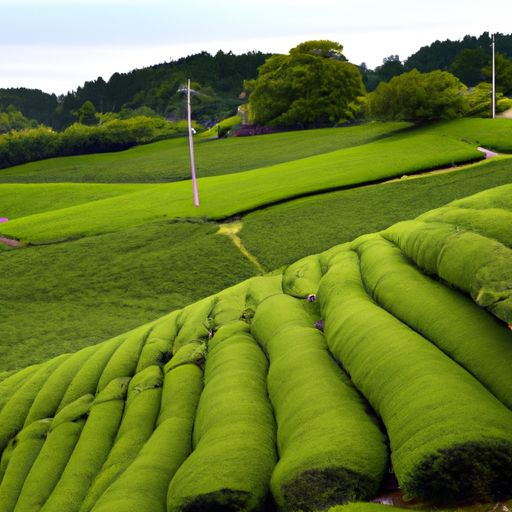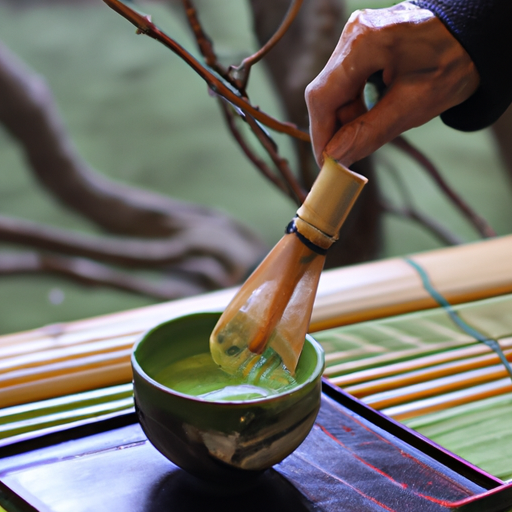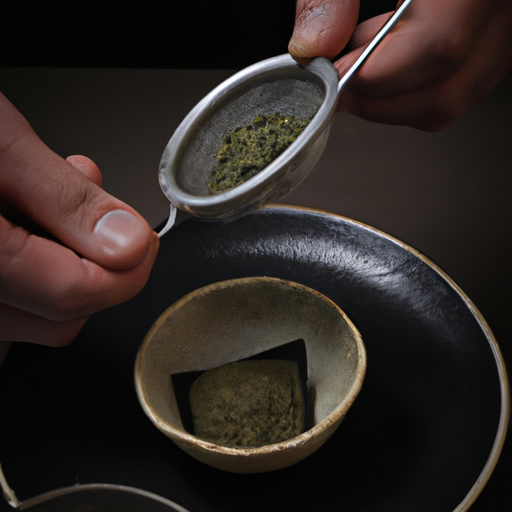Sipping my warm matcha, I’m struck by its vivid green hue and distinctive taste, a favorite tea from Japan that has surged in popularity recently. You’ll find it featured in cafés and on supermarket shelves worldwide. But, have you ever pondered the origins of this delightful tea?
Well, my friend, you’re in luck because today we’re diving into the history and origins of matcha. Symbolizing tranquility, harmony, and purity, matcha has been an integral part of Japanese culture for centuries. However, its roots stretch back even further to ancient China, where tea was first discovered and cultivated.
So, let’s take a journey through time and explore the fascinating world of matcha.
Key Takeaways
- Matcha is a beloved Japanese tea that symbolizes tranquility, harmony, and purity.
- Matcha has been an integral part of Japanese culture for centuries and is an essential element in Japanese tea ceremonies.
- Matcha is made from shade-grown tea plants and ground into a fine powder using traditional stone mills, resulting in a bright green hue and umami taste.
- Matcha is rich in antioxidants and catechins and has numerous health benefits, and it is produced using specialized farming techniques in Japan.
Brief History of Tea in Asia
Tea has been an integral part of Asian culture for centuries, with the first known consumption of tea dating back to China in the 3rd century AD. Tea cultivation in China began during the Han Dynasty, and it quickly spread throughout Asia.
By the 9th century, tea had become a popular beverage in Japan, and traditional tea ceremonies were developed to celebrate the art of preparing and serving tea. In Japan, the tea ceremony, or chanoyu, is a cultural practice that emphasizes harmony, respect, purity, and tranquility. The ceremony is rooted in Zen Buddhism and is considered a form of meditation.
During the ceremony, matcha, a finely ground green tea powder, is prepared and served to guests in a tranquil setting. The ceremony is a way of honoring the tea and the guests, and it is a way of connecting with nature, oneself, and others. Matcha, the star of the traditional Japanese tea ceremony, has its origins in China.
It was introduced to Japan during the Tang Dynasty, around the 7th century, and it became a popular beverage among Japanese monks and samurai. The tea leaves used to make matcha are grown in the shade, which enhances the flavor and texture of the tea. The leaves are then harvested, steamed, dried, and ground into a fine powder. The powder is whisked with hot water to create a frothy, vibrant green tea that has a unique flavor and aroma.
The Origins of Matcha
Originating in Japan, matcha is a powdered green tea that has been enjoyed for centuries. This tea is made from the leaves of shade-grown tea plants, which are then ground into a fine powder using traditional stone mills. Matcha has a vibrant green color and a unique flavor that sets it apart from other types of tea.
Matcha has long been an integral part of traditional Japanese tea ceremonies. In fact, some estimates suggest that more than 800 of these ceremonies take place each day in Japan. This tea has a deep cultural significance, representing harmony, respect, purity, and tranquility.
Matcha is not only culturally significant but also has numerous health benefits. This tea is rich in antioxidants, which can help protect the body against damage from free radicals. Additionally, matcha is high in catechins, a type of antioxidant that has been shown to boost metabolism and aid in weight loss.
Transitioning into the subsequent section about the role of matcha in Japanese tea ceremonies, it’s important to note that matcha is not just a drink but a part of a cultural tradition that has been passed down for generations.
The Role of Matcha in Japanese Tea Ceremonies
I’m excited to delve into the role of matcha in Japanese tea ceremonies.
Tea ceremonies have a rich history and cultural significance in Japan, often serving as a way to honor guests and promote mindfulness.
Matcha, being the powdered form of green tea, is an essential element in these ceremonies and requires a specific preparation and serving process.
History and significance of tea ceremonies
The significance of matcha in Japanese culture can be seen in the elaborate and highly ritualistic tea ceremonies that have been practiced for centuries. These ceremonies are not just about drinking tea, but about the entire experience of preparing and serving it, as well as observing the etiquette and customs associated with it. The tea ceremony is a way to bring people together, to appreciate the beauty of nature, and to cultivate a sense of peace and harmony.
Tea ceremony etiquette is a crucial aspect of these ceremonies, and it is important to follow the customs and traditions associated with it. For example, guests are expected to bow to the host before entering the tea room, and to follow a specific order when entering and sitting. The host prepares and serves the tea, and guests are expected to observe the tea and the tea utensils with appreciation and respect. The cultural significance of tea ceremonies is profound, as it represents a deep appreciation for simplicity, beauty, and harmony. It is a way of connecting with others, with nature, and with oneself. With this in mind, let us delve into the preparation and serving of matcha.
Preparation and serving of matcha
Getting ready to enjoy a cup of matcha involves specific steps and techniques that have been passed down for generations in Japanese culture. There are several varieties of matcha, each with its unique flavor and aroma. Generally, the highest quality matcha has a sweet, vegetal taste with a hint of astringency.
Ceremonial preparation of matcha involves sifting the powder into a bowl and adding hot water, which is then whisked with a bamboo whisk until frothy. The temperature of the water is crucial to ensure the best flavor and aroma. It’s recommended to use water that’s around 175°F or 80°C. The ratio of water to matcha powder, the whisking technique, and the type of bowl used also play a significant role in the final taste and texture of the matcha.
The unique flavor and color of matcha make it a popular beverage worldwide. The vibrant green hue and creamy texture of the froth add to its appeal. However, the flavor and aroma are what make matcha truly exceptional.
The next section will delve deeper into the unique taste and aroma that matcha offers.
The Unique Flavor and Color of Matcha
You’ll notice the vibrant green color and distinct taste of matcha, which sets it apart from other teas. Matcha’s flavor profile is characterized by its umami taste, which is both savory and slightly sweet.
The color of matcha comes from the high concentration of chlorophyll in the tea leaves, which is responsible for its bright green hue. When it comes to color variations, matcha can vary from a light green to a deep emerald green, depending on the quality of the tea leaves and the growing conditions.
High-quality matcha is made from shade-grown tea leaves, which results in a darker green color and a more intense umami flavor. The color of matcha can also be affected by the way it is prepared and served, such as the addition of milk or other ingredients.
In addition to its unique flavor and color, matcha is also known for its health benefits. From boosting energy and metabolism to providing a rich source of antioxidants, matcha has become a popular choice for those looking to improve their overall well-being.
So the next time you sip on a warm cup of matcha, not only will you enjoy its unique taste and vibrant color, but you’ll also know that you’re doing something good for your body.
Health Benefits of Matcha
With its numerous health benefits, it’s no wonder that matcha has become a popular choice for those looking to improve their overall well-being. One of the main reasons for this is the high concentration of antioxidants found in matcha. In fact, matcha contains up to 137 times more antioxidants than regular green tea. These antioxidants help to protect the body from free radicals, which can cause cell damage and lead to chronic diseases such as cancer.
In addition to its antioxidant content, matcha is also packed with vitamins and minerals. One serving of matcha contains vitamin C, vitamin A, potassium, and calcium, among other nutrients. These nutrients work together to improve immune function, support bone health, and regulate blood sugar levels. Matcha is also known to contain an amino acid called L-theanine, which has been shown to improve focus, reduce stress levels, and boost overall brain function.
Overall, the nutritional value of matcha makes it a great addition to any diet. Its high levels of antioxidants and nutrients make it a powerful tool in promoting overall health and well-being. In the next section, we’ll explore how matcha is used in culinary applications and the unique flavor it adds to dishes.
Matcha in Culinary Applications
I’m excited to talk about the culinary applications of matcha!
Matcha is not only a popular drink, but it’s also a versatile ingredient in baking and cooking.
From matcha cakes to matcha ice cream, there are many delicious matcha-based dishes and desserts to try.
Use in baking and cooking
When you’re experimenting with matcha in your baking and cooking, you’ll discover its unique flavor and versatility. Matcha can be used in various recipes, from sweet desserts to savory dishes. Here are some ways to incorporate matcha into your culinary creations:
-
Use matcha powder in place of cocoa powder or spices like cinnamon or ginger to add a unique flavor profile to baked goods like cookies, cakes, and brownies.
-
Mix matcha powder into frosting or whipped cream to top off your favorite desserts.
-
Add a teaspoon of matcha powder to your smoothie or cocktail for a vibrant green color and a boost of antioxidants.
With these ideas, you can elevate your recipes with the distinct taste of matcha. But it’s not just for sweet dishes and drinks.
In the next section, we’ll explore some popular matcha-based dishes and desserts that showcase its versatility.
Popular matcha-based dishes and desserts
You’ll be amazed at the variety of mouth-watering matcha-based dishes and desserts that you can try! Matcha has become a popular ingredient in the culinary world, and it’s not hard to see why.
Matcha based drinks, such as matcha lattes, have become a staple in many coffee shops. Matcha can be used in baking to create delicious matcha flavored snacks, such as cookies, cakes, and even ice cream. Matcha’s unique flavor and vibrant green color make it a versatile ingredient that can be used in a variety of dishes.
Aside from drinks and snacks, matcha has also been incorporated into more complex dishes such as matcha soba noodles, matcha risotto, and even matcha-infused soups. Matcha’s earthy and bitter taste pairs well with savory dishes, and it’s not uncommon to see it used in Japanese and Asian cuisine.
For those with a sweet tooth, matcha desserts such as matcha cheesecake, matcha mochi, and matcha macarons are delicious treats that showcase the ingredient’s unique flavor.
Matcha’s versatility in the culinary world is truly impressive. However, have you ever wondered about the history of matcha and how it’s produced and harvested? Let’s dive into the next section to learn more about the production and harvesting of matcha.
Production and Harvesting of Matcha
To produce matcha, farmers in Japan use specialized matcha farming techniques and carefully shade the tea plants for three weeks before harvesting. This shading process results in high levels of chlorophyll and amino acids in the leaves, which gives matcha its distinct flavor and color.
After harvest, the leaves are steamed, dried, and sorted by quality before being ground into a fine powder using traditional stone mills. Matcha production methods have remained largely unchanged for centuries, with the focus on producing the highest quality matcha possible.
The shading process is crucial to the development of the leaves, as it slows down their growth and increases their nutrient content. Farmers also use special harvesting techniques, such as hand picking and sorting, to ensure that only the best leaves make it into the final product.
Did you know that it takes about one hour to grind just 30 grams of matcha? This slow, careful process ensures that the powder is ground to the perfect consistency, with no lumps or clumps.
The resulting matcha powder is then sorted by quality into different grades, which are used for different purposes. In the next section, we’ll explore the differences between ceremonial and culinary grade matcha and how they’re used.
Differences between Ceremonial and Culinary Grade Matcha
Get ready to discover the nuances between ceremonial and culinary grade matcha and how each type enhances your daily routine.
Ceremonial matcha is the highest quality of matcha and is traditionally used in Japanese tea ceremonies. It is made from the youngest leaves of the Camellia sinensis plant, which are shade-grown for several weeks before harvesting. The leaves are then stone-ground into a fine powder, resulting in a bright green color and a smooth, delicate flavor profile with a hint of sweetness.
On the other hand, culinary matcha is made from older leaves and stems of the Camellia sinensis plant and is typically used for cooking or baking. It has a slightly bitter taste and a more muted green color compared to ceremonial matcha. While it is not as high quality as ceremonial matcha, it is still a great option for adding the health benefits of matcha to your daily diet at a more affordable price point.
In terms of flavor profiles, it is important to note that ceremonial matcha is intended to be consumed on its own, while culinary matcha is often used as an ingredient in recipes. Ceremonial matcha has a delicate, subtle flavor that is best enjoyed without any added sweeteners or other flavors. On the other hand, culinary matcha has a stronger, bitter flavor that can be masked by other ingredients in recipes.
Understanding the differences between ceremonial and culinary matcha can help you choose the right type for your needs and preferences, and ultimately enhance your daily routine with this superfood ingredient.
As we’ve seen, the differences between ceremonial and culinary matcha extend beyond just their intended uses. But no matter which type you choose, matcha has become a global phenomenon for its health benefits and unique flavor.
In the next section, we will explore the global popularity of matcha and how it has been incorporated into various cultures and cuisines around the world.
Global Popularity of Matcha
Matcha has become a trendy and sought-after ingredient worldwide, with its unique flavor and health benefits being incorporated into various cuisines and products across the globe.
The popularity of matcha in Western culture has skyrocketed in the past few years, with many coffee shops, cafes, and restaurants adding matcha-based drinks and dishes to their menus.
Matcha has also made its way into beauty and skincare products, with its antioxidant properties being praised for improving skin health.
Matcha is often compared to traditional green tea, but they are not the same. While both come from the same plant, Camellia sinensis, matcha undergoes a different cultivation and processing method.
Matcha leaves are shade-grown for a few weeks before harvest, which increases the concentration of chlorophyll and amino acids in the leaves.
After harvesting, the leaves are steamed, dried, and ground into a fine powder. The resulting powder is then whisked with hot water to make a frothy and vibrant green tea.
The global popularity of matcha has also led to an increase in the production of high-quality matcha.
Japan is still the largest producer of matcha, but other countries have also started to cultivate and produce their matcha.
However, not all matcha is created equal, and it’s important to choose high-quality matcha from trusted sources.
With its unique flavor and health benefits, matcha is here to stay as a global superfood and ingredient.
Frequently Asked Questions
How is matcha different from other types of tea?
Matcha is a tea like no other. It’s like a symphony of flavors dancing on your tongue, with a smooth and creamy texture that’s hard to resist.
But what really sets matcha apart from other teas is its health benefits. Packed with antioxidants, matcha can help boost your immune system, reduce inflammation, and even lower your risk of chronic diseases. And let’s not forget about its calming effects, thanks to the amino acid L-theanine.
But don’t be fooled by its delicate taste and texture – matcha is a powerhouse of nutrients that can do wonders for your body and mind. So if you’re looking for a tea that’s both delicious and nutritious, look no further than matcha.
What is the traditional method for preparing matcha?
To prepare matcha in the traditional method, I start by sifting the matcha powder through a fine mesh sieve to ensure there are no clumps.
Next, I add hot water to the matcha bowl and whisk the powder with a bamboo whisk until it’s frothy and smooth.
The water should be at a temperature of about 175°F to 180°F.
The proportion of water to matcha is usually about 2-3 ounces of water to 1 teaspoon of matcha powder.
This method of matcha preparation is called ‘Usucha’ or thin tea.
For a more concentrated and thicker tea, a method called ‘Koicha’ is used where a higher amount of matcha powder is used and less water is added.
This traditional method of matcha preparation has been used in Japan for centuries and is still widely practiced today.
Are there any cultural or religious significance to matcha in Japan?
As a lover of Japanese culture, I’m fascinated to learn about the cultural and religious significance of matcha in Japan.
Matcha has been an integral part of Japanese tea ceremonies for centuries, with its preparation and consumption being seen as a form of art. The tea ceremony, also known as Chanoyu, is deeply rooted in Zen Buddhism and is considered a way to cultivate mindfulness and inner peace.
Matcha is also used in Shinto rituals, where it’s offered to deities as a symbol of purity and respect.
Beyond religious practices, matcha has become a cultural symbol of Japan, representing its attention to detail, simplicity, and appreciation for nature. Its popularity continues to grow worldwide, and for good reason – its rich history and cultural significance make it more than just a delicious beverage.
What are some common culinary uses for matcha?
Matcha is a versatile ingredient that can be used in a variety of culinary applications. Some of the most popular uses for matcha include making matcha desserts and matcha drinks.
Matcha desserts can range from classic Japanese sweets like mochi and wagashi, to more modern creations like matcha cheesecake and matcha ice cream. Matcha drinks are also popular, with matcha lattes and matcha smoothies being common offerings at cafes and juice bars.
Matcha can also be used as a flavoring agent in savory dishes, such as matcha pasta and matcha-infused sauces. As someone who’s extensively researched matcha and its uses, I can confidently say that it’s a versatile and delicious ingredient that can enhance a wide range of dishes.
How does the production process of matcha differ from other types of tea?
When it comes to matcha production, there are unique techniques and sustainable practices that set it apart from other types of tea. The process of producing matcha involves growing tea plants in shaded areas, which helps to increase the chlorophyll content and create a vibrant green color.
After the leaves are harvested, they are steamed and dried before being ground into a fine powder using traditional stone mills. This grinding process is what gives matcha its distinctive texture and flavor.
Unlike other teas, matcha is consumed in its entirety, which means that it contains higher levels of antioxidants and other beneficial compounds. To ensure that matcha production remains sustainable, growers use organic farming methods and carefully manage the amount of shade that the tea plants receive.
Overall, the production process of matcha requires a great deal of skill and attention to detail, but the end result is a delicious and healthy beverage that is beloved around the world.
Conclusion
In conclusion, I’ve learned that matcha is a unique and flavorful green tea that originated in Japan. Its vibrant green color and rich taste make it a popular choice for both tea ceremonies and culinary applications worldwide.
Not only is matcha delicious, but it also boasts numerous health benefits, including high levels of antioxidants and the ability to boost metabolism and energy levels.
I can’t help but wonder, with all the amazing benefits and delicious taste of matcha, why isn’t it more commonly consumed in other parts of the world? Perhaps it’s time for us to embrace this ancient Japanese tradition and incorporate matcha into our daily lives.
Whether we enjoy it in a traditional tea ceremony or use it in innovative culinary creations, matcha has something to offer everyone. So why not give it a try and experience the magic of matcha for yourself?










